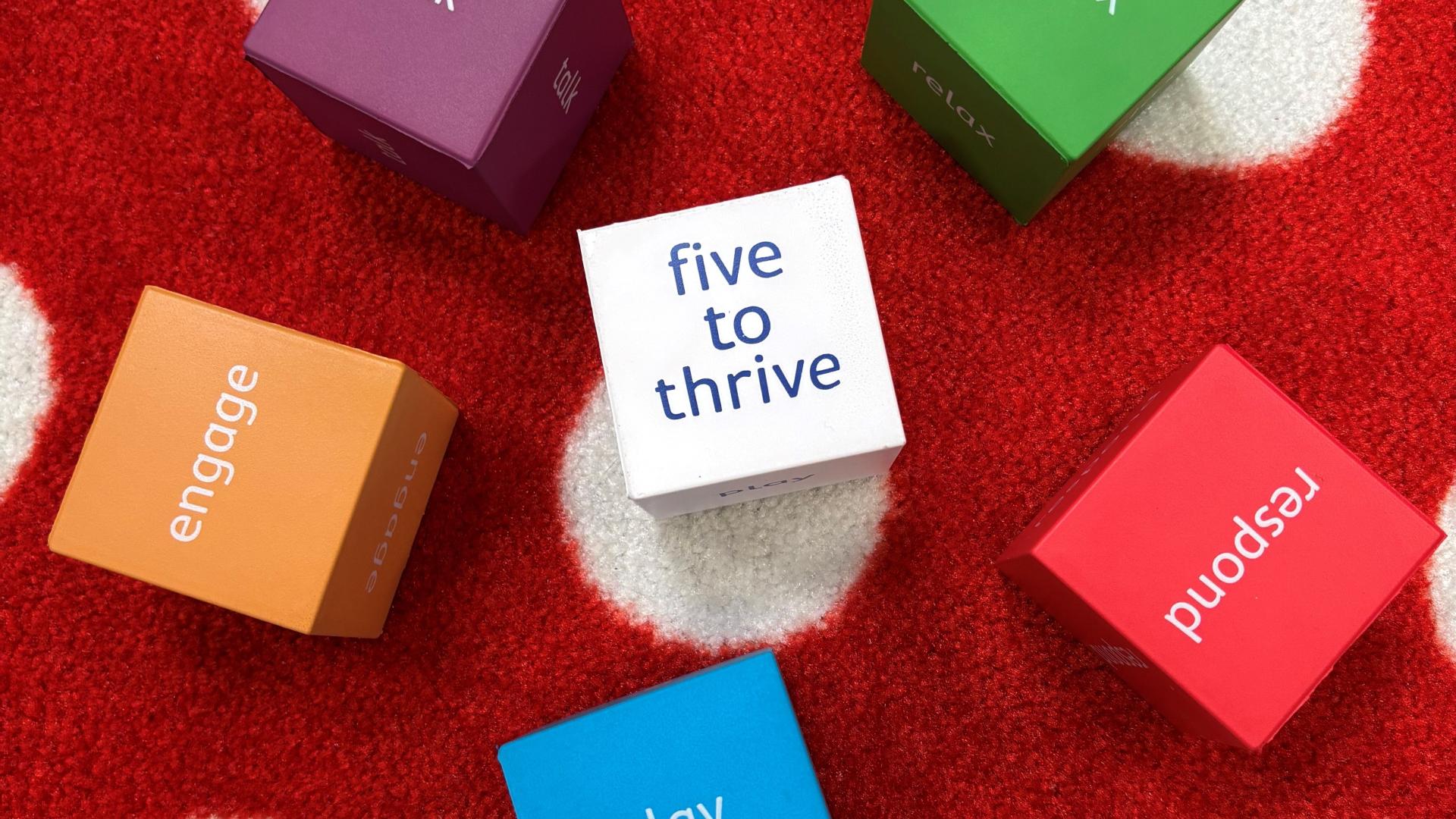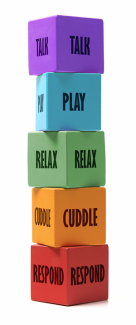
You can read about the Five to Thrive strategy here and this is a great starting place to understanding the approach. But it's important to remember that it can be a useful strategy for all ages and experiences (including adults). Here, we look at Five to Thrive and our SEN families.
All day, every day the brain is forming connections, linking brain cells together to carry information about our experiences, our hopes and our dreams. Information also passes from one brain to another: we live in a network of connected brains, and the feelings and intentions of other people help to form connections in our own brains.
So, what happens to your child shapes their brain, and the most important thing that happens to your child is you! You are the centre of their network. Everything you do when you are with your child sparks connections in their brain, turning connections into pathways that the child can use again.
For connections to grow in a child’s brain, the child needs to be connected to an adult. So the brain and body, feelings and thoughts of your child have been tuning in to what is happening in your brain and body. This strong bond means that you will also be affected by the changes in the brain and body of your child.
Children with disabilities live with extra challenges. All children need a close brain-and-body link to adults because they cannot always manage or make sense of their own feelings and thoughts. They need an adult to do that for them, an adult who is tuned in to the world of the child. So, living with the sometimes chaotic brain of a child can be chaotic, and living with the brain of a child who faces extra challenges can be very challenging!
They can be confusing because they feel confused
They can be frustrating because they feel frustrated
They can be infuriating because they feel infuriated
They can even be frightening because they feel frightened
But remember
They can also be delightful because they feel such delight in living
They can be very lovable because they love you so much
Your child’s body grows better when you give the child good food. Your child’s brain grows better when you do five simple things that feed the growing brain - Respond • Cuddle • Relax • Play • Talk

Respond
Responding involves tuning into another person’s emotions, accepting their stress, and helping them regulate it. Barriers to responsiveness include stress and distractions, which can make individuals feel ignored or unsupported. Recognising and valuing responsiveness in ourselves and others is crucial. If children’s need for responsive interactions isn’t met, they may struggle with identity, safety, bonding, and emotional regulation. Adults can support children by learning their unique cues, being patient even when met with hostility, and making connections with trusted adults to create a sense of security.
“My brain is very active, but it still can’t work on its own. I need my brain to be linked to the brain of an adult. Adults can manage their thoughts and feelings and behaviour, because they have brains that control their responses. But my brain can’t do this yet. I need you to respond to me so that I can learn to manage my own responses.”
Suggestions:
- If they are able to see, your child will watch the expression on your face and the way you use your hands and your body to know how you are responding to them.
- If they are able to hear, they will listen carefully to the sounds you make to see how you are feeling.
- They also need chances to sort things out for themselves, to process information, so wait-and-see can sometimes be a good response.
Useful Links
Cuddle/Engage
Engagement is key to connection and co-regulation, requiring awareness of physical proximity, eye contact, posture, and voice tone. Observing and understanding engagement helps identify when someone is connected or withdrawn. Adults can support engagement by adjusting their approach—using different positions, tones, or levels of interaction to find what comforts rather than overwhelms. If engagement needs aren’t met, children may struggle with recognising emotions, social motivation, and empathy. Teaching others about engagement’s importance ensures children receive the support they need to build meaningful connections.
“When you are close to me I can pick up your feelings in my body. This helps me to feel safe and protected, and this feeling of safety helps my brain to settle and get things sorted out. And if you feel happy when I am close to you this makes me feel that I am a real person who can make a difference to other people.Then my brain can work out what makes me feel safe and happy, and what I can do to make other people feel safe and happy.”
Suggestions:
- Your child needs physical closeness, and will give you signals about what sort of closeness helps them to feel safe – holding hands, brushing hair, massage, stroking, tickling, or just being close in the same space.
- If being too close is uncomfortable for your child, then you can let them know that you are keeping them in mind by talking or singing or humming from a distance.
- Children love to give as well as receive the comfort of physical closeness and being held in mind.
Relax
Relaxation is essential for emotional balance and effective brain function. Throughout life, we rely on others to help us regulate stress through co-regulation. As co-regulators, we must first calm ourselves, allowing the other person to relax. Self-regulation strategies include adjusting posture, deep breathing, movement, and changing thoughts. If children’s regulation needs aren’t met, they may experience hyperarousal, reduced concentration, or dissociation. Adults can support regulation by consciously staying calm, matching a child’s emotional state, and then guiding them to self-regulate. Teaching others about co-regulation ensures stronger emotional resilience in children and families
“My brain is so active and I find things confusing. I often feel frustrated and stressed! I still can’t manage stress by myself – if I didn’t have you to help me take the stress away it could build up to a point where it started to injure my brain. But because I love and trust you, I am tuned in to you. I need you to get stressed and then to relax, and that helps me to stop being stressed and to relax. And when I relax with you my brain starts to sort out how to do that all by myself.”
Suggestions:
- Children with disabilities face extra challenges. They are likely to struggle to manage stress, and need to tune in to your brain and body to calm themselves down.
- Helping your child to self-regulate can be stressful. You need to be part of a network of adults who can give you the support you need to support your child. See how Five to Thrive can help you find your support network here
Useful Links
- Scope - emotional support for families
- Coping when things get tough
Play
Play activates the social and emotional brain through non-verbal communication, such as facial expressions, body language, and gestures. This type of interaction allows the co-regulator to connect on an emotional level, helping the other person understand and process emotions more effectively. Non-verbal cues enable a reciprocal give-and-take of engagement, relaxation, and responding, which promotes emotional connection and understanding. Practicing playful, non-verbal communication through activities like mirroring helps build social skills and emotional regulation. If children’s needs aren’t met in play, they may struggle with reciprocity, cooperation, or managing emotions like shame. Adults can support children by being mindful of their non-verbal communication and practicing playfulness to foster healthy connections.
“Playing helps me to make sense of the world. I like it when you are playful with me, and when you help me to find ways to play on my own. I take notice of you and learn from you all the time, even when you don’t know it. When you play with me it really helps me to think and understand and make sense of my world.”
Suggestions:
- Children learn through play. Singing games, counting games, action games, let’s pretend games can all help the child to make sense of the world around them.
- Play that involves using hands – drawing, cutting, cooking – and play that involves movement – running, balancing, throwing and catching – all helps to develop the way the brain controls the body.
- Play that involves the senses – seeing, hearing, touching, tasting, smelling – helps to get the brain working as one organised unit.
- Play that involves imagination – dolls, stories, dressing up – helps the child to develop thinking skills and understanding.
Useful Links
Talk
Talk activates the cognitive and rational brain through verbal communication. From the moment babies are born, the words used by adults—whether during play, engagement, relaxation, or responsiveness—help shape their developing brain. What is said to a child, especially during moments of overwhelm, can have a lasting impact. Adults need to listen empathetically, speak honestly, and stay consistent even when the other person seems unresponsive. Positive verbal interactions, including storytelling, repetition, and checking comprehension, help children develop thinking, language, and communication skills. When these needs aren’t met, children may struggle with understanding speech, distinguishing between reality and fantasy, or managing time. Adults can support children by building language skills, using simple, clear language, and checking for understanding.
“Words, signs, symbols and objects are so important to me because these are what make my brain work together in an organised way.I love it when you take notice of what I am communicating to you. It helps me to feel that I am a real person who matters, and it helps me to build patterns for communicating. I love it when you talk to me, or read to me, or sing to me, or find other ways to communicate with me about my experiences.”
Suggestions:
- Communicating with your child using words, symbols, signs and objects helps to shape the way their brain is getting organised.
- Reading and the use of interactive stories e.g. Storysacks, is a part of helping to develop shared experiences on which to build, making it easier for them to continue to learn throughout their lives.
- Songs, poems, rhymes and putting words to actions are great ways to get children interested in having fun with communicating.
Useful Links
For more support and guidance please see the below links
Further information
How to use Five to Thrive if your child has Autism or non verbal
Take a look at how each block can be used to support your autisic and/or non verbal child